I remember my first pizza bite—crispy crust, melted cheese, and sharing with friends. This moment shows pizza’s power: it crosses borders and generations. It’s more than food; it’s a shared joy.
Numbers show pizza’s amazing story. Over five billion pizzas are eaten worldwide each year. In the US, three billion are enjoyed. Italy and Norway love it too, with Italy eating 1.6 billion slices and Norway eating 27.5 slices per person.
The first pizza place, Antica Pizzeria Port’Alba, opened in 1830 in Naples. The first frozen pizza patent was in 1954. Today, Domino’s has 18,300 locations, showing pizza’s growth.
In this guide, we’ll explore pizza’s history and today’s gourmet pizzas. We’ll see how wood-fired ovens made Neapolitan classics and how truffle toppings change modern pizzas. Pizza’s story is not just history; it’s alive in every bite. Let’s find out why this simple dish became a global icon.
The Origins of Pizza: A Historical Perspective
Naples, Italy, is where authentic Italian pizza first emerged. In the 16th century, the city’s working-class people made simple flatbreads with tomatoes, cheese, and herbs. These early pizzas evolved into the marinara and margherita styles we love today by the 18th century.
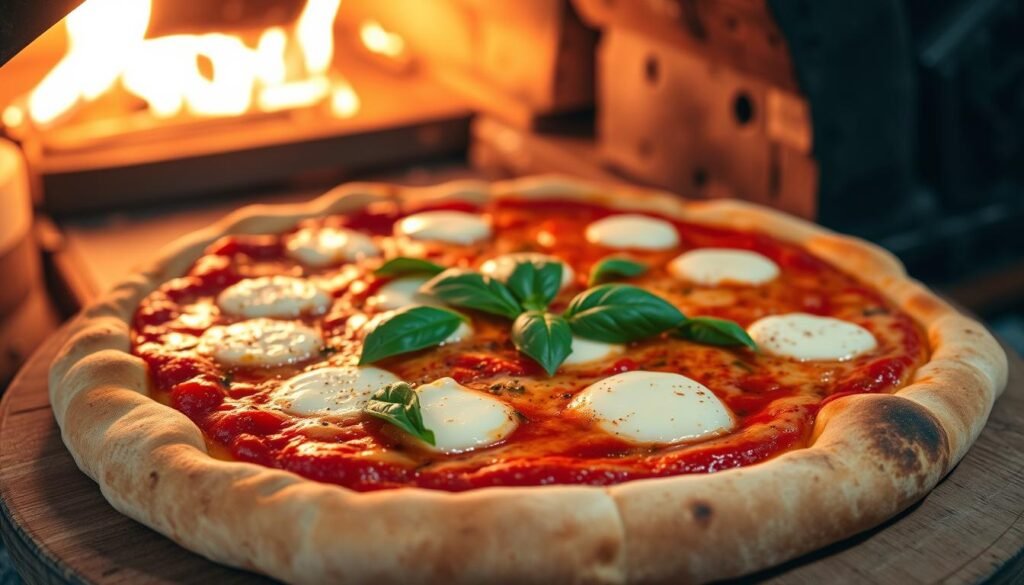
“The real pizza is born from simplicity,” says the Associazione Verace Pizza Napoletana, the group that safeguards traditional Neapolitan methods.
Key Historical Milestones
- 1738: The first recorded use of the term “pizza” appeared in Naples’ cookbooks.
- 1889: Chef Raffaele Esposito created Pizza Margherita, using basil, mozzarella, and tomato to symbolize Italy’s flag.
- 1905: G. Lombardi’s in New York became America’s first licensed pizzeria, marking the start of pizza’s global journey.
How Immigrants Spread Authentic Italian Pizza
Italian immigrants brought their pizza recipes to the U.S. They adapted them to local tastes. By the mid-20th century, cities like New York and Chicago developed their own pizza styles. Today, Naples’ traditions are protected by the European Union’s “Traditional Specialty Guaranteed” certification.
Pizza’s Global Evolution
Authentic Italian pizza has inspired many variations worldwide. Yet, its roots remain in Naples. UNESCO recognized Neapolitan pizza-making as intangible cultural heritage in 2017, showing its lasting importance.
Different Types of Pizza Around the Globe
Pizza has traveled from Naples to cities all over. Each place adds its own twist, making dough into a creative canvas. See how global flavors change what the best pizza in town can be.
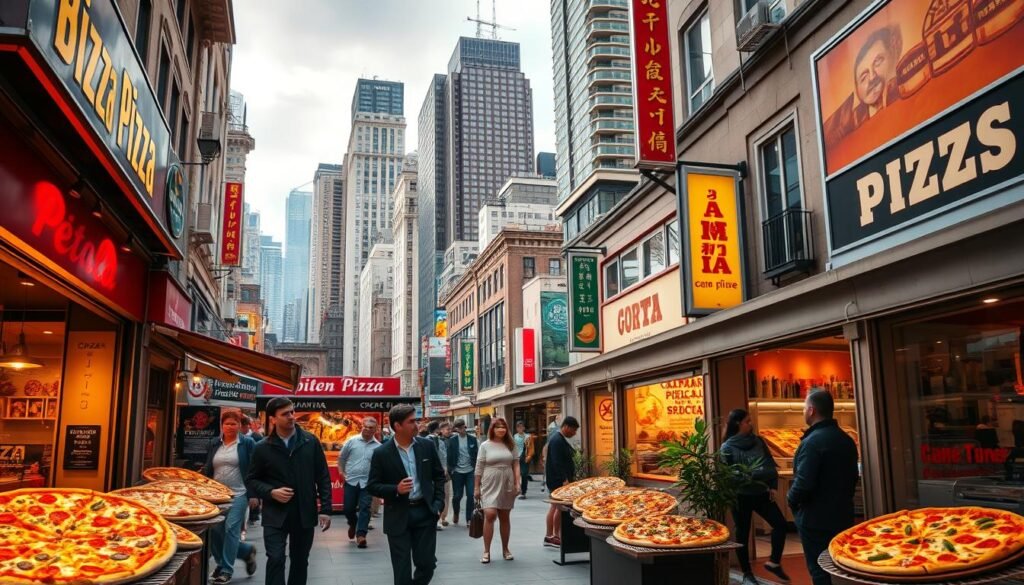
| Region | Unique Toppings |
|---|---|
| Japan | Squid, mayo, mayonnaise |
| India | Paneer, tandoori chicken |
| Brazil | Nutella, banana, cinnamon |
| Canada | Regina-style’s biscuit-dough base |
Neapolitan Pizza: Tradition at Its Finest
This pizza comes from Naples and is loved worldwide. It’s made with San Marzano tomatoes and fresh mozzarella. Cooked in 90 seconds at 900°F, its crust is light and perfect.
New York-Style Pizza: A Local Favorite
In NYC, you’ll find foldable pizza slices everywhere. The crust is thin, and the toppings are simple yet delicious. It’s a classic street food.
Chicago Deep-Dish: A Hearty Experience
This pizza was invented in the 1940s. It’s all about layers: cheese, meat, and sauce in a buttery pan. The sauce goes on top, making it cheesy and filling.
Popular Global Variations
Around the world, pizzas are getting creative. Thai pizzas use peanut sauce, and Korean ones add bulgogi. Even Sweden has a pizza with lamb kebab and yogurt sauce. The best pizza in town might just be something you’ve never tried before.
The Ingredients That Make Pizza Special
Every slice of pizza starts with ingredients chosen to boost flavor and texture. From the dough to the toppings, each step is key. Let’s see how these elements come together for perfection.
Dough: The Foundation of a Great Pizza
True Neapolitan pizza uses 00 flour and slow fermentation. The Associazione Verace Pizza Napoletana requires a wood-fired pizza oven for authenticity. These ovens get up to 800–900°F, making the crust perfectly charred.
My pizza journey started after a decade brewing beer. A Japanese pizza inspired me to learn about dough. I use a 12-hour fridge rest and high-gluten flour for the right elasticity. The oven’s heat is what makes the crust special.
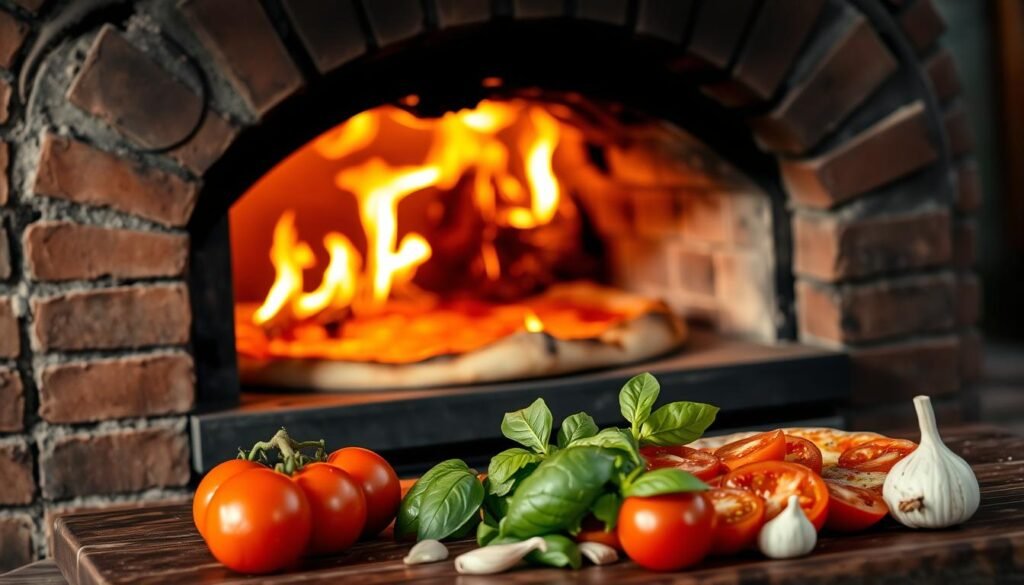
Sauce: The Secret Ingredient
A classic sauce is made with San Marzano tomatoes and salt only. No herbs or sugars are added. This simplicity lets the tomato’s sweetness stand out.
My recipe follows this simple rule. The Associazione’s strict standards ensure it’s authentic. But, there’s room for creativity beyond traditional.
Cheese: Finding the Perfect Melt
Mozzarella is the top choice. I use fresh buffalo milk mozzarella for softness and low-moisture for stability. Aged cheeses like Old Gold add a unique finish.
Never use low-fat cheese—it doesn’t melt right. Whole milk mozzarella is what I look for for that perfect gooey stretch.
Toppings: The Art of Customization
- Prosciutto, speck, or mortadella for savory depth
- Arugula or basil for freshness
- Truffle oil or chili flakes for bold twists
Pair your pizza with natural wines—sparkling or light red. They enhance the toppings without overpowering them. No beer needed; the pizza is enough.
The Rise of Gourmet and Artisan Pizzas
Pizza has grown from a simple snack to a gourmet treat. Gourmet pizza delivery services now bring these high-quality pies right to your door. This change shows a growing desire for better taste, with 62% of people choosing artisanal options over quick, easy meals.
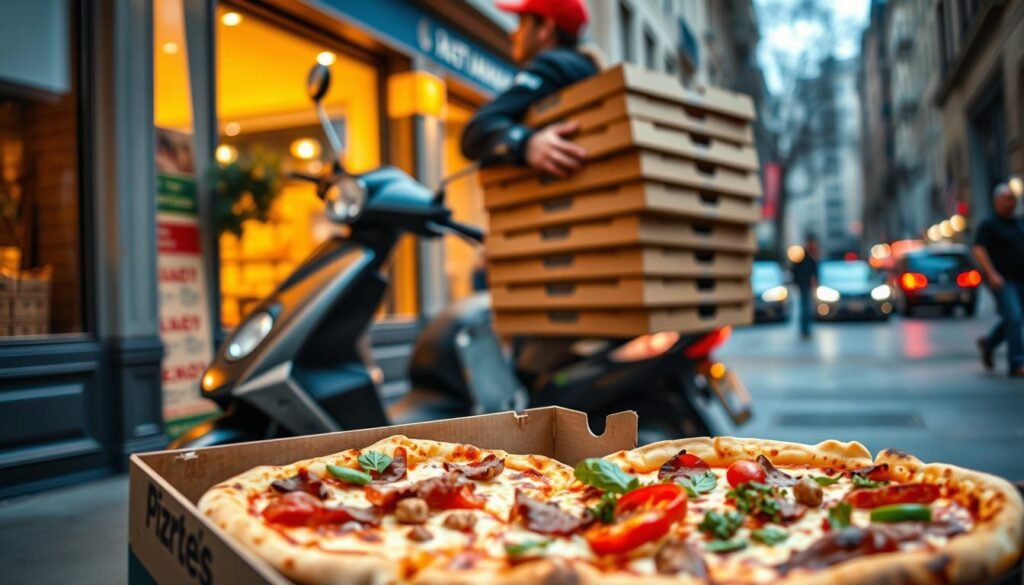
What Defines Gourmet Pizza?
Gourmet pizza is known for its top-notch ingredients and careful making. It features homemade sauces, aged cheeses, and dough that’s fermented for 72 hours. Pizzerias are now using fancy toppings like truffle oil and heirloom tomatoes. This makes it different from regular pizza.
Popular Trends in Artisan Pizzas
- Fusion flavors: Korean BBQ and tikka masala pizzas are now on menus, up 40% in three years.
- Organic toppings: Sales of organic basil and grass-fed mozzarella have risen 25% as more people want them.
- Plant-based options: Vegan cheese and chickpea flour bases make up 35% of new menu items.
“The best artisan pizza starts with soil—not a factory,” says Executive Chef Elena Torres of Rome’s La Piazza Antica. “Every ingredient should tell a story.”
How Local Ingredients Elevate Pizzas
Artisan makers work with local farmers to get fresh ingredients. They use wild mushrooms in fall and sun-dried tomatoes in summer. This approach has led to a 30% increase in regional pizzerias using 70% of ingredients from within 50 miles. Even gourmet pizza delivery chains like Knead Pizza now highlight their farm partnerships on their packaging.
The gourmet pizza market is growing 10.5% every year. It’s not just a trend—it’s a big change in how we see pizza.
How Pizza Became a Cultural Icon in America
I’ve followed pizza’s path from Italy to a symbol of American life. In 1905, G. Lombardi’s opened in NYC, the first U.S. pizzeria. After WWII, soldiers coming home wanted pizza, making it more popular. By the 1950s, Pizza Hut and Domino’s made it a national favorite.
Pizza in American Pop Culture
Pizza is everywhere in American stories, from Home Alone to Saturday Night Fever. Even music talks about it, like Frank Sinatra’s That’s Amore. This made pizza a symbol of comfort and community for all ages.
Celebration and Pizza: A Growing Tradition
Family-friendly pizzerias became key spots for birthdays and holidays. Kids and grandparents share slices, starting traditions that last. These places are where families come together, enjoying gooey cheese and warm crusts.
Pizza and Sports: The Perfect Pairing
Super Bowl Sundays and baseball games go hand in hand with pizza. A 2023 survey found 68% of fans order pizza during games. Pizza Hut and others offer deals for these moments, making it more than just food—it’s a tradition.
Healthier Pizza Options: A Modern Approach
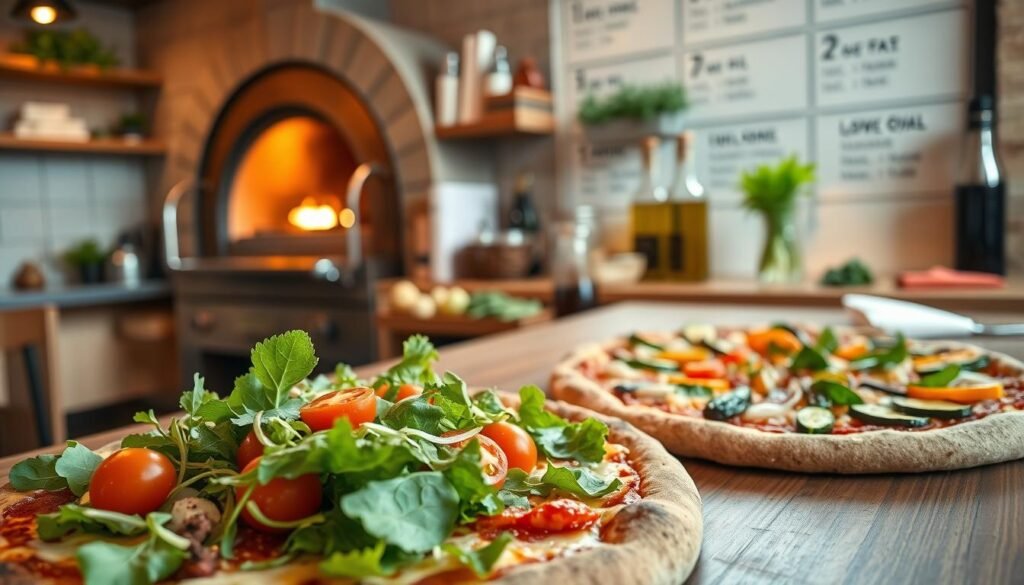
Top-rated pizzeria chefs are making pizzas healthier without losing flavor. They use cauliflower crusts and vegan cheese. This shows how old traditions meet new wellness trends.
“Consumers demand healthier choices, and top-rated pizzerias are delivering,” says a 2023 industry report.
Cauliflower and Gluten-Free Crusts
Many top-rated pizzerias now offer cauliflower-based crusts. These crusts have 1/3 fewer carbs than traditional dough. For example:
- Jet’s Thin Crust Veggie offers 230 calories per slice, 500 mg sodium, and 3g saturated fat.
- Papa Murphy’s Garden Veggie has 180 calories and 370 mg sodium per serving.
Healthy Toppings: Going Green
Lean proteins like grilled chicken and spinach are replacing processed meats. Studies show less saturated fat can lower heart disease risks. Top rated pizzerias now highlight:
- California Pizza Kitchen’s veggie option: 170 calories, 340 mg sodium.
- Papa John’s vegan cheese melts like dairy-based options with 280 mg sodium.
The Vegan Pizza Trend
Plant-based cheeses from brands like Follow Your Heart and Beyond Meat are on menus. For instance:
- Papa Murphy’s vegan pizza has 14g carbs and 8g protein.
- Marco’s Thin Crust Vegan Option: 14g carbs and 6g protein.
USDA data shows 35% of Americans now choose lower-sodium pizzas. Top rated pizzerias are leading this shift. They prove healthy eating and flavor can go together.
Pizza Delivery: A Game-Changer
Pizza delivery changed how we enjoy this favorite dish. In the 1960s, Domino’s Pizza introduced its 30 minutes or less promise. This made delivery a key part of its success. Now, Domino’s has over 18,300 locations worldwide, showing its huge growth from a small loan.
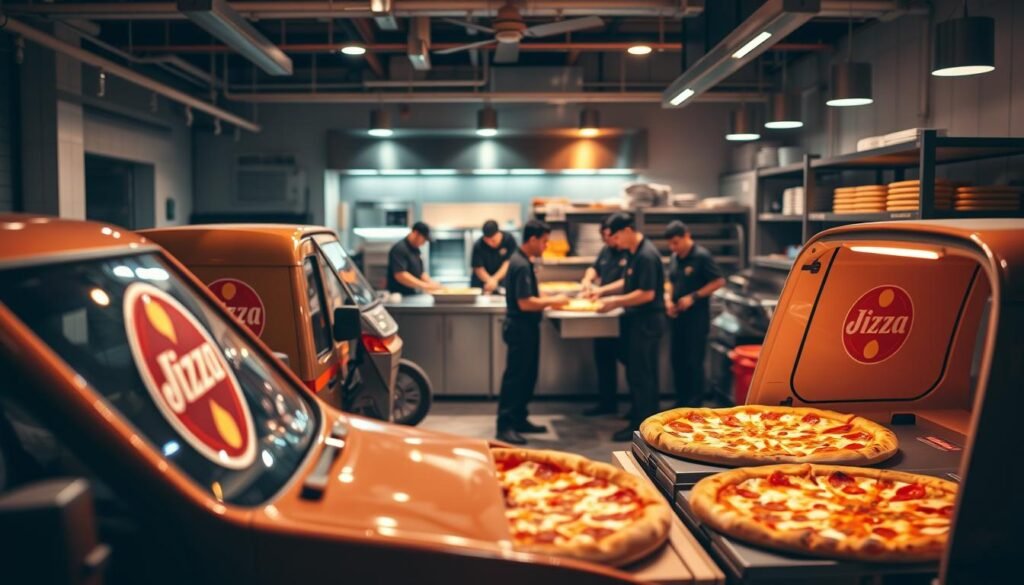
The Evolution of Pizza Delivery Services
At first, delivery was done by phone and local routes. Domino’s led the way with speed, and Pizza Hut followed. By the 2000s, delivery faced issues like 20% of orders being late. This led to the use of new technology.
The Rise of Online Ordering
Today, mobile apps and websites are key for ordering. Customers can pick toppings, track their pizza, and pay online. Domino’s app alone handles millions of orders each year, showing the move to digital.
Innovations in Delivery Technology
- GPS tracking systems reduce delays
- Delivery vehicles with built-in warmers keep pizzas fresh
- Experimental drone deliveries aim to cut wait times further
Pizza catering has grown beyond home deliveries. It’s used for corporate events, weddings, and festivals, making the U.S. industry worth $46 billion. Even delivery drivers, like Eric Decker, have become famous online, earning over $1 million a year on YouTube. This mix of technology and tradition keeps pizza delivery at the top of food service.
Pizza Inventions That Changed the Game
Every slice of pizza has a Pizza Story behind it. These stories are shaped by tools and techniques that changed everything. From Naples to the world, these innovations made pizza what it is today.
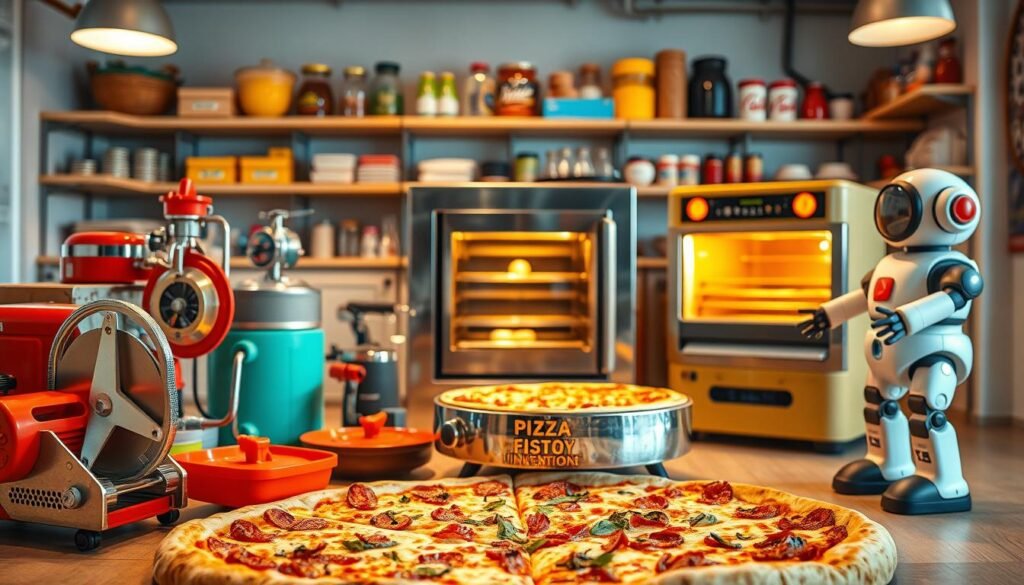
The Pizza Cutter: A Simple Slice of Genius
Before pizza cutters, chefs used knives that crushed toppings. The curved blade design, patented in the 1950s in America, made clean slices possible. This tool became a must-have in pizzerias everywhere.
Pizza Ovens: Heating Up the Game
| Type | Origin | Impact |
|---|---|---|
| Wood-fired | Naples | Traditional smoky flavor |
| Conveyor belt | 1950s US | Mass production efficiency |
| Artisanal electric | Modern era | Home oven replication |
Frozen Pizza: The 1950s Breakthrough
In 1954, Joseph Bucci’s frozen pizza technique changed the game. It allowed for nationwide home delivery of pre-made dough. Today, companies like DiGiorno and Tombstone make $4 billion a year. This invention made pizza a staple in homes.
- Pizza stones (1970s): even heat distribution)
- Insulated delivery bags (1980s: kept pies crisp)
- Automated dough mixers (2000s: consistency at scale)
These inventions kept the Pizza Story alive and growing. From street food to a global favorite, pizza’s journey is fascinating.
The Future of Pizza: Trends to Watch
The pizza industry is set for big changes. Expect to see more sustainable ingredients and tech in kitchens. Here’s what’s coming.
Plant-Based Pizzas: A Sustainable Future
Plant-based pizzas are gaining popularity fast. Companies like Vegolutionary Foods make pizzas with cauliflower crusts. Norwegians eat 27.5 pizzas a year, and vegan cheese is becoming a favorite.
The world is moving towards greener food choices. Expect to see more eco-friendly options on menus.
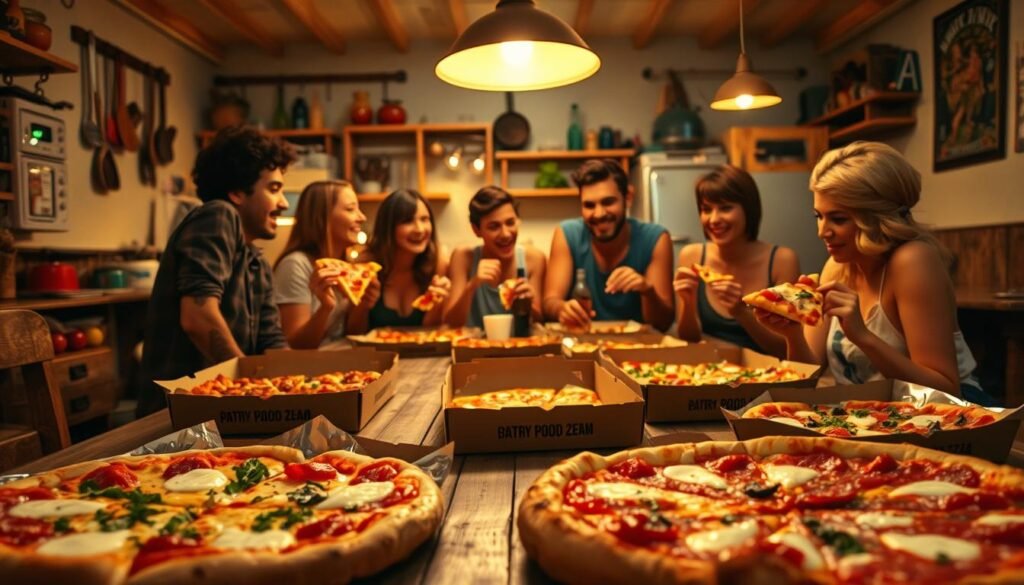
Tech Innovations in Pizza Production
Automation is changing how pizzas are made. AI-driven ovens and automated topping systems make perfect pizzas every time. Domino’s is leading with tech like GPS for delivery.
Online ordering is now 38.75% of sales. More places are using apps that remember what you like.
The Experience Factor: Dine-In vs. Delivery
Restaurants are focusing on both taste and atmosphere. Pizza party packages come with drinks and themes for parties. With 48% of sales from catering, these party packages are essential.
Some places offer DIY kits, while others pair pizzas with craft beer. The personal touch, like hand-tossed dough, is what makes them stand out.
As labor costs go up, tech like self-serve kiosks helps save time. But, the human touch is what keeps customers coming back.
Famous Pizzerias: A Culinary Journey
From old brick ovens to local favorites, America’s top pizzerias mix tradition with warmth. They keep classic recipes alive while welcoming families. This offers a taste of history.
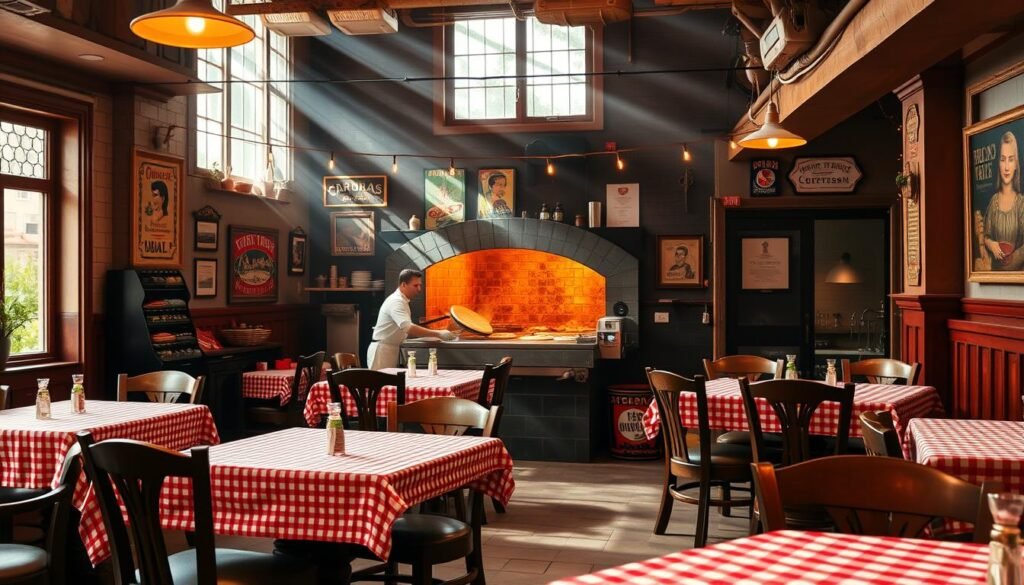
Explore New York’s Iconic Pizzerias
- Lombardi’s (1905): The U.S.’s first licensed pizzeria, serving coal-fired pies in Little Italy.
- Di Fara: Dom DeMarco has been making award-winning pies by hand for over 50 years.
- Totonno’s (1924): A Coney Island favorite with a menu unchanged for decades.
Chicago’s Must-Try Deep-Dish Spots
Deep-dish pioneers shape the Windy City’s pizza scene:
- Pizzeria Uno (1943): Ike Sewell’s creation started Chicago’s deep-dish tradition.
- Lou Malnati’s: Offers a buttery crust and a lighter deep-dish style.
- Giordano’s: Famous for stuffed-crust and over 40 topping choices.
Hidden Gems Across the U.S.
| Pizzeria | Location | Signature Style |
|---|---|---|
| Frank Pepe’s (New Haven) | Connecticut | Apizza with charred crust |
| Buddy’s Ristorante | Detroit | Square-cut, crispy-crust Detroit-style |
| Mario’s | NYC’s Bronx | Offering classic thin-crust options for over 100 years |
These spots are beloved family pizzerias, sharing recipes through generations. At John’s of Bleecker Street, families enjoy a 1929 setting. It shows pizza’s lasting charm. Whether it’s a coal-fired slice or a hearty deep dish, these places connect us to pizza’s rich history.
Pizza Pairings: Food and Drink Combinations
Hosting a pizza party? The right drinks and sides can make it unforgettable. Whether you’re planning pizza party packages or just having friends over, these pairings will make every bite special.
“There’s nothing like a perfect slice with the right drink,” said Elizabeth Gilbert (Julia Roberts’ character in Eat, Pray, Love).
Beer:Light lagers are great with creamy white pizzas. Hoppy IPAs balance bold meats. Malty brown ales are perfect with spicy pepperoni.Wine:Chianti’s acidity is great with Margherita pizzas. Zinfandel complements meat lovers. For white pizzas, crisp Sauvignon Blanc is a winner.
- Pale ales pair well with BBQ chicken, balancing its sweetness.
- Crisp Prosecco adds sparkle to seafood-topped pies.
- For non-alcoholic options, lemonade brightens vegetable toppings.
Sides:Garlic knots add crunch. Antipasto platters offer salty contrasts. A simple green salad refreshes rich deep-dish styles.
Planning pizza party packages? Match drinks to toppings: spicy pizzas with tangy Bloody Marys, or creamy quattro formaggi with Negronis. These tips ensure every element harmonizes, making your next gathering a hit.
The Communities Built Around Pizza
Pizza’s warmth goes beyond the kitchen, touching neighborhoods and traditions. It brings families and local businesses together, strengthening communities.
Pizza Nights: A Family Tradition
Across America, families gather on weeknights for pizza. “Pizza Fridays” are more than meals; they’re weekly rituals. These nights create lasting memories, showing how simple meals can anchor busy lives.
Local Pizzerias and Their Impact
Joanie’s Pizza in Chelmsford, Massachusetts, is a great example. It started during the pandemic, focusing on quality takeout and delivery. They also support local events and offer pizza catering services for fundraisers and parties.
Their pizza, made for travel, symbolizes adaptability. It shows pizza can bridge gaps, even in tough times.
Pizza Festivals: Celebrating a Beloved Dish
The International Pizza Expo in Las Vegas highlights innovation. But, it’s hometown festivals that truly unite locals. Festivals in Naples or Chicago draw crowds, but small-town fairs are special.
These events celebrate togetherness, turning strangers into neighbors. They’re not just about food; they’re about community.
Pizza’s power is in its ability to unite us. Whether at family dinners or festivals, it’s more than a meal. It’s a thread that weaves us together.







